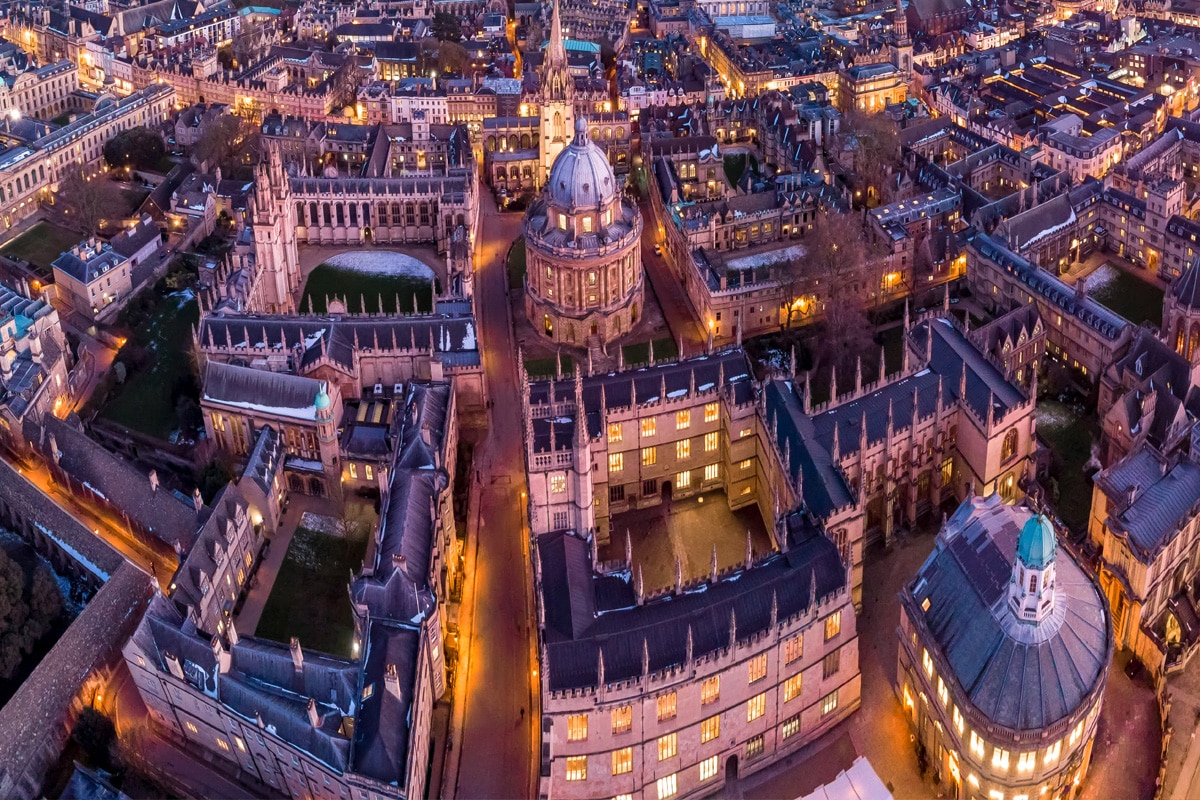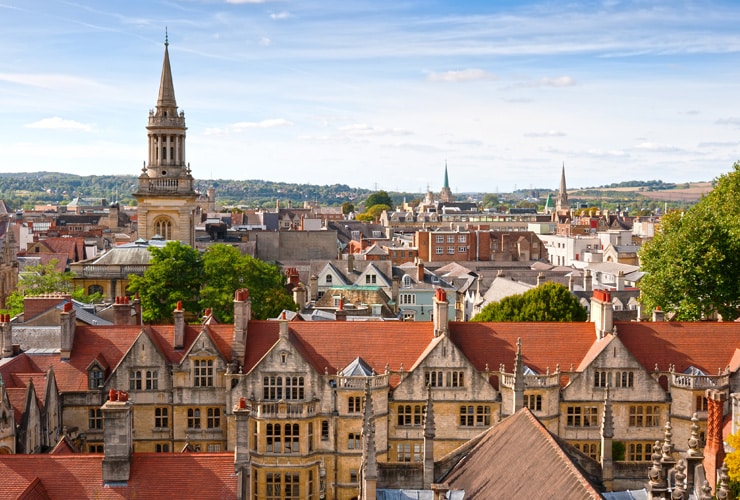Areas of Oxford: Buy-to-Let Property Investment Hotspots
Oxford’s image as a city of dreaming spires couldn’t be more wrong today! It may be one of the prettiest small cities around – but it is also an economic powerhouse and a global name in education, research and technology. That means Oxford has a fast-expanding population and a hot property market to go with it, making it a highly attractive location for property investment.
Why Invest in Oxford?
Oxford has a strong and diverse economy, a vibrant culture, and a prestigious academic reputation, making it an attractive prospect for property investors. Here are some key reasons why investing in Oxford property is worth considering:
- A Strong Economy: Oxford boasts one of the strongest economies in the UK. In 2018, Oxford was recorded as contributing £21.9 billion to the UK economy. The city's economy is expected to grow further, with excellent employment opportunities and a talented workforce of 434,800.
- An Education Hub: Oxford is renowned for its world-class educational institutions, including the University of Oxford, ranked as the top university in the world. The city attracts a large student population, creating high demand for rental properties and graduate talent for employers.
- Tourism: Oxford is a popular tourist destination, welcoming 7 million visitors annually. The city's cultural attractions, museums, galleries, and historical sites contribute to its appeal, generating over £780 million in income for local businesses.
- Transport Links: Oxford has excellent transport links, with easy access to London and other major cities. The East-West Rail Project will make Oxford even more accessible.
- A Diverse Property Market: Oxford offers a diverse range of properties, including apartments, townhouses, terraced houses, and detached homes. The city caters to various budgets and preferences, making it attractive to investors targeting different demographics.
- Regeneration Projects: Oxford is undergoing regeneration projects, the Paradise Street development being one recent example of how the city is revitalising and attracting new residents.
- High Rental Demand: Oxford has a high demand for rental properties, driven by its young population and professional demographic. The city's rental yields are promising, with the potential for strong returns on investment.
- Capital Appreciation: Oxford's property market has strong potential for capital appreciation. While specific projections for the city are not readily available, the South East region, which includes Oxford, is projected to see house price growth of 13.3% by 2026.
- A Stable Environment: Oxford is a stable city with a low unemployment rate of less than 1% and a highly-trained workforce. The city's economy is expected to continue thriving, making it a secure investment choice.
- Foreign Investment: Oxford attracts significant foreign direct investment (FDI), creating new jobs and strengthening its economy. This has contributed to the city's regional success and appeal to domestic and international investors.
- A Knowledge-Based Economy: Oxfordshire, the county in which Oxford is located, utilises a 'knowledge-based' economy, fostering sustainable growth. The region has a highly-trained workforce and a growing number of active businesses, positioning it for long-term success.

Transport Links
Oxford's location is one of its key advantages, offering excellent transport links for residents and visitors. The city is situated on the M40, A40, A34, and A44 roads, with London just an hour away. Oxford also benefits from a comprehensive bus network, including the Park and Ride service, and two rival 24/7 coach services to and from London.
Oxford's train connections are also impressive, with regular direct services to London Paddington and Marylebone, Birmingham International, and Stansted, among other destinations. The city's train station, located on Park End Street, is operated by First Great Western. Additionally, Oxford Parkway, a new out-of-town station, offers two trains per hour to London Marylebone, with stops at Bicester Village.
Oxford is set to become even better connected with upcoming developments. East-West Rail will eventually link Oxford with Bicester, Milton Keynes, Bedford, Cambridge, and other communities. The Oxford-Cambridge Expressway, a motorway-standard road, is also in the works, further enhancing the city's connectivity.
Property Values
Oxford typically has some of the highest property prices in the UK, second only to London and Cambridge. As of July 2024, the average property price in Oxford is £460,000, with a median price of £383,000. However, prices vary significantly across the city.
The most affordable area in Oxford is OX16 5, with an average property price of £168,000. In contrast, the most expensive area is OX2 6, with an average price of £1.5 million.
The average sold price for a property in Oxford in the last 12 months is £539,051, according to Zoopla. However, this varies depending on the type of property. The average price for a terraced house is £544,502, while a detached house will set you back £958,269, on average.
For first-time buyers, the average property price in Oxford is £404,198, with a required deposit of £69,158. The most affordable area for first-time buyers is Banbury (OX16), with an average house price of £226,484. Cowley, Blackbird Leys, Littlemore, and Iffley (OX4) also offer more affordable options, with a range of amenities and easy access to the city centre.
Oxford's property market has been thriving, with prices increasing by 12.3% between May 2022 and May 2023. This reflects the city's strong local economy and its appeal as an investment destination, particularly for student accommodation.
While Oxford's property prices are high, there are still opportunities to find cheaper properties in certain areas, especially when considering the surrounding villages and towns.
Average Asking Price by Postcode Area
Last updated: July 2024
Data from HM Land Registry
| Postcode District | Average Property Price |
|---|---|
| OX1 | £556,482 |
| OX2 | £669,291 |
| OX3 | £504,887 |
| OX4 | £446,420 |
| OX5 | £467,852 |
Rental Demand
Oxford has a strong rental market, driven by high housing demand and a limited supply of properties. The city's rental demand increased by 38% year-on-year, according to SpareRoom.
The imbalance between supply and demand has resulted in intense competition among applicants, with some properties receiving multiple enquiries within hours of being listed. This dynamic means that applicants have to be decisive, finding themselves having to take properties unseen or needing to offer above the asking rent to secure their desired home.
The demand for rental properties in Oxford is fuelled by several factors. Firstly, the city's high property prices make homeownership challenging, with average house prices over 15 times the average salary in 2022. This dynamic has led to an increase in the number of households renting in the private sector, which rose by almost 14% between 2021 and 2022.
Secondly, Oxford's status as a desirable location, with its prestigious university and medical institutions, attracts a diverse range of renters, including students, academics, and young professionals. The presence of the university also contributes to the demand for rental properties, as students seek accommodation near campus.
The high rental demand in Oxford has resulted in increased competition among applicants, with properties letting quickly, often on the first viewing. The demand for larger homes and properties with outdoor space has been particularly notable, with some applicants requesting the removal of furniture to create more space.
As of April 2024, the average rent in Oxford is £2,777 per calendar month (PCM). With a monthly, average net salary of £1,946, tenants in Oxford will find themselves spending a significant proportion of their income on rent.
Overall, Oxford's rental market is characterised by high demand, limited supply, and intense competition among applicants, making it a favourable environment for landlords.
Average Rental Yield by Postcode Area
Rental yield is the rental return an investor can expect on their investment once costs have been taken into consideration.
Last updated: July 2024
| Postcode District | Average Rental Yield |
|---|---|
| OX1 | 4.0%/td> |
| OX2 | 3.6% |
| OX3 | 4.0% |
| OX4 | 4.4% |
| OX5 | 4.2% |
Landlord Licensing
Oxford City Council has recently implemented a selective licensing scheme, requiring all privately rented homes to obtain a licence. This includes houses, flats, and bungalows, whether rented to families or individuals. The scheme was enacted on 1 September 2022 and will run for five years.
Selective Licensing
The selective licensing scheme covers almost half of Oxford's housing stock. Previously, only Houses in Multiple Occupation (HMOs) required a licence, but these make up less than 15% of privately rented homes in Oxford.
The stated aim of selective licensing schemes is to ensure that all rented properties are safe, well-maintained, and properly managed. Whether they achieve this, however, is open for debate.
As of April 2024, the cost of a selective licence is £480 for a five-year licence. Accredited landlords are eligible for a discounted fee of £280. Failure to obtain the necessary licence can result in fines of up to £30,000, and tenants can apply for a rent repayment order to claim back their rent from unlicensed landlords.
Article 4 Direction
Oxford City Council also introduced an Article 4 Direction in February 2011, which came into force in February 2012. This direction removes permitted development rights, meaning that planning permission is required for converting a dwelling house into an HMO. This applies to the entire Oxford City Council area.
HMO Licensing
In addition to the selective licensing scheme and as is true for all of England and Wales, Oxford has mandatory and additional HMO licensing requirements. A mandatory HMO licence is needed for properties with five or more occupants forming two or more households. The additional HMO licensing scheme covers 3 or 4-person HMOs.

The Best Places to Live in Oxford
Oxford offers a range of desirable neighbourhoods, each with a unique character and appeal. Here are some of the best places to live in the city:
- Jericho: Located just north of the city centre, Jericho is a vibrant and cosmopolitan area with a bohemian vibe. It attracts a cool crowd and boasts independent shops, eclectic cafes, and a lively nightlife scene. The area features beautiful Georgian and Victorian architecture and is a designated conservation area. While rent can be above average, Jericho offers a great balance between being close to the buzz of the city centre and enjoying a more peaceful, village-like atmosphere.
- Summertown: Summertown is a sought-after area, particularly for families and retirees. It offers a mix of boutiques, restaurants, and bars, along with spacious accommodation and parking options. Summertown is also known for its connection to J.R.R. Tolkien, with his grave located just north in Wolvercote.
- Cowley Road: This ethnically diverse neighbourhood is known for its array of world-food restaurants, bars, and speciality food stores. While rising rents have led to gentrification, Cowley Road remains a vibrant and eclectic base, offering a range of culinary delights from around the globe.
- Headington: Headington is a popular choice for students from Oxford Brookes University, with the main campus easily accessible. It's part of the slightly more bohemian east of the city and is home to several popular student pubs. Headington offers large terraced Victorian houses, perfect for group living.
- Marston: Located in the north-east of Oxford, Marston is a quiet, village-like neighbourhood that's popular with families. It has good schools and a few local shops, pubs, and restaurants. While there aren't many attractions, Marston offers peaceful outdoor spaces with playgrounds and walking trails.
- East Oxford: This neighbourhood, east of the city centre, offers something for everyone. You'll find schools, pubs, restaurants, and green spaces. It's also home to the Science Oxford Centre, the curious Headington Shark, Shotover Country Park, and Oxford Golf Club.
- Grandpoint and Abingdon Road: This area offers a more rural and country feel, with parks and riverside walks. It's ideal for those seeking a quieter lifestyle, and it's still just a short walk or bus ride from the city centre.
Property Investment in Oxford
Here are a few tips on some of the different areas of Oxford for property investors:
The City Centre
Oxford city centre is really popular with university students, as well as professionals, and so great for buy-to-let. It’s worth noting that it can be hard to find property investments here though, as much of Oxford city centre property is owned by the universities or student accommodation providers.
Expect yields here (OX1 postcode) of up to about 4.3%.
Cowley Road
Cowley Road used to be regarded as a fairly run-down area of Oxford. In recent years though, this multicultural area – renowned for the annual Cowley Road Carnival – has become a fashionable residential spot. It’s an area where shrewd investors might still find some cheap property by Oxford standards.
A good investment property here might return a 5% yield.
Jericho and Park Town
Ten minutes north of the city centre Jericho and Park Town are smart and fashionable districts. Jericho, in particular, is known for its independent shops, bars and cafes and its nightlife. It’s an area that particularly appeals to young people, as well as students.
Yields in OX2, generally, are around 3%.
Summertown
Summertown is one of Oxford’s most upmarket districts and also one of its most expensive – thanks, partly, to the top independent schools that are located here. It is a particular favourite of wealthy business people, professionals and academics at the universities.
Yields here are tight at about 3%.
Headington
Headington is Oxford’s largest suburb and is made up of several districts including New Headington and Headington Hill. Headington has its own high street and local amenities yet still offers good access into the city. Headington is a mid-priced area for Oxford and is particularly popular with families, students at Oxford Brookes University and staff who work at John Radcliffe Hospital.
Yields here (OX3) are 4%.
Cowley
Cowley is the main industrial and commercial suburb of Oxford. Oxford Business Park, in particular, is home to a number of employers including cutting edge tech. companies and large organisations such as the NHS, British Gas, Royal Mail, Oxfam and Oxford County Council.
Cowley plus other areas of south Oxford such as Littlemore, Florence Park and Rose Hill are generally cheaper areas to buy property – by Oxford standards that is. Property investors may be able to find good value here, plus yields of 5% (OX4 area).
Iffley
Iffley is a village on the fringes of Oxford close to the River Thames and Iffley Meadows. It’s a sought-after place to buy or rent for professionals and older families.
Yields here are in the range of 3-5%.
Botley
To the west of Oxford, Botley is a mid-upper market residential area with its own local amenities whilst also being 10-15 minutes into the city centre. It also benefits from direct access to the A34 for longer-distance commuters.
Botley yields are in the range of 3-4%.
Other Areas To Consider
High Oxford property prices mean investors could also consider areas nearby, which offer cheaper property investments as well as attractive yields.
Kidlington
Kidlington is a small town just north of Oxford. It’s more workaday and more affordable than most Oxford suburbs. While it is popular with Oxford commuters it is self-contained with its own shops, schools and amenities and a number of business parks offering employment.
Also at Kidlington is London Oxford Airport. Oxford Airport is one of the UK’s smallest airports but is an important base for pilot training, light aircraft and executive planes.
Yields here (OX5) are 4%.
Abingdon
Abingdon (or Abingdon-on-Thames as it is properly known) is a market town to the south of Oxford. It’s world-famous as the original home of MG cars. Commuters can reach Oxford city centre in 20-30 minutes by road or by train from nearby Radley railway station in just 6 minutes.
Yields here are likely to be 3-4%.
